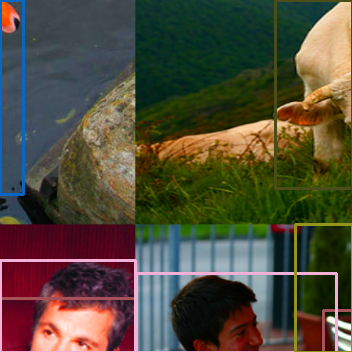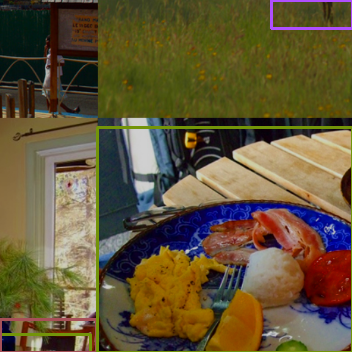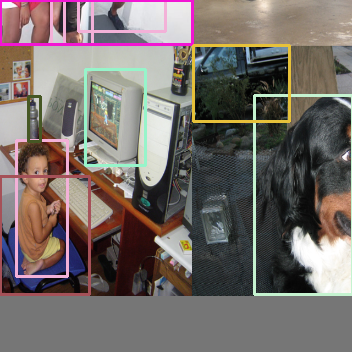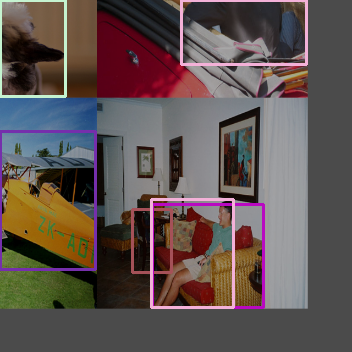English | 简体中文
- We recommend you to use Anaconda to create a conda environment:
conda create -n yolo python=3.6- Then, activate the environment:
conda activate yolo- Requirements:
pip install -r requirements.txt My environment:
- PyTorch = 1.9.1
- Torchvision = 0.10.1
At least, please make sure your torch is version 1.x.
- Mosaic Augmentation
- Mixup Augmentation
- Multi scale training
- Cosine Annealing Schedule
| Configuration | |
|---|---|
| Per GPU Batch Size | 16 (8 for FreeYOLOv2-Huge) |
| Init Lr | 0.01 |
| Warmup Scheduler | Linear |
| Lr Scheduler | Linear |
| Optimizer | SGD |
| Multi Scale Train | True |
| Mosaic | True |
| Mixup | True |
- Download COCO.
cd <FreeYOLOv2_HOME>
cd dataset/scripts/
sh COCO2017.sh- Check COCO
cd <FreeYOLOv2_HOME>
python dataset/coco.py- Train on COCO
For example:
python train.py --cuda -d coco -m yolo_free_v2_nano -bs 16 --max_epoch 300 --wp_epoch 3 --eval_epoch 10 --fp16 --ema --root path/to/COCOP5-Model on COCO:
- FreeYOLOv2
| Model | Scale | Epoch | FPS3090 FP32-bs1 |
APval 0.5:0.95 |
FLOPs (G) |
Params (M) |
Weight |
|---|---|---|---|---|---|---|---|
| FreeYOLOv2-Pico | 640 | 300 | - | 32.1 | 4.5 | 1.4 | ckpt |
| FreeYOLOv2-Nano | 640 | 300 | 100 | 35.3 | 9.0 | 2.8 | ckpt |
| FreeYOLOv2-Small | 640 | 300 | 86 | 43.3 | 33.3 | 8.8 | ckpt |
| FreeYOLOv2-Medium | 640 | 300 | 71 | 47.5 | 86.7 | 23.0 | ckpt |
| FreeYOLOv2-Large | 640 | 300 | 66 | 49.4 | 175.4 | 46.5 | ckpt |
-
All FLOPs are measured with a 640x640 image size on COCO val2017. The FPS is measured with batch size 1 on 3090 GPU from the model inference to the NMS operation.
-
A large batch size such as 128 or 256(I have to set it as 16.) may further improve the performance of FreeYOLOv2-Medium and FreeYOLOv2-Large.
-
Increasing Epoch to 500 may further improve the performance of FreeYOLOv2.
-
Due to my performance limitations, I am unable to train the FreeYOLOv2-Huge model.
-
Download WiderFace.
-
Prepare WiderFace
WiderFace
|_ WIDER_train
| |_ images
| |_ 0--Parade
| |_ ...
|_ WIDER_tval
| |_ images
| |_ 0--Parade
| |_ ...
|_ wider_face_split
|_ eval_tools
- Convert WiderFace to COCO format.
cd <FreeYOLOv2_HOME>
python tools/convert_widerface_to_coco.py --root path/to/WiderFace- Check WiderFace
cd <FreeYOLOv2_HOME>
python dataset/widerface.py- Train on WiderFace For example:
python train.py --cuda -d widerface --root path/to/WiderFace -m yolo_free_v2_nano -bs 16 --max_epoch 100 --wp_epoch 1 --eval_epoch 10 --fp16 --ema --pretrained path/to/coco/yolo_free_v2_nano_coco.pth --mosaic 0.5 --mixup 0.0 --min_box_size 1Main results on WiderFace-val:
| Model | Scale | AP | AP50 | Weight |
|---|---|---|---|---|
| FreeYOLOv2-Pico | 640 | 29.9 | 55.1 | ckpt |
| FreeYOLOv2-Nano | 640 | 31.3 | 56.9 | ckpt |
| FreeYOLOv2-Small | 640 | 33.5 | 60.1 | ckpt |
| FreeYOLOv2-Medium | 640 | 34.8 | 61.7 | ckpt |
| FreeYOLOv2-Large | 640 | 35.5 | 62.6 | ckpt |
- Download CrowdHuman.
CrowdHuman
|_ CrowdHuman_train01.zip
|_ CrowdHuman_train02.zip
|_ CrowdHuman_train03.zip
|_ CrowdHuman_val.zip
|_ annotation_train.odgt
|_ annotation_val.odgt
- Prepare CrowdHuman
CrowdHuman
|_ CrowdHuman_train
| |_ Images
| |_ 273271,1a0d6000b9e1f5b7.jpg
| |_ ...
|_ CrowdHuman_val
| |_ Images
| |_ 273271,1b9330008da38cd6.jpg
| |_ ...
|_ annotation_train.odgt
|_ annotation_val.odgt
- Convert CrowdHuman to COCO format.
cd <FreeYOLOv2_HOME>
python tools/convert_crowdhuman_to_coco.py --root path/to/CrowdHuman- Check CrowdHuman
cd <FreeYOLOv2_HOME>
python dataset/crowdhuman.py- Train on CrowdHuman
For example:
python train.py --cuda -d crowdhuman -m yolo_free_v2_nano -bs 16 --max_epoch 100 --wp_epoch 1 --eval_epoch 10 --fp16 --ema --root path/to/CrowdHuman --pretrained path/to/coco/yolo_free_v2_nano.pthMain results on CrowdHuman-val:
| Model | Scale | AP | MR | JI | Weight |
|---|---|---|---|---|---|
| FreeYOLOv2-Pico | 640 | 82.4 | 53.1 | 69.8 | ckpt |
| FreeYOLOv2-Nano | 640 | 84.1 | 50.3 | 71.8 | ckpt |
| FreeYOLOv2-Small | 640 | 86.5 | 45.6 | 75.0 | ckpt |
| FreeYOLOv2-Medium | 640 | 87.5 | 43.4 | 76.2 | ckpt |
| FreeYOLOv2-Large | 640 | 88.2 | 42.1 | 76.8 | ckpt |
sh train.shYou can change the configurations of train.sh, according to your own situation.
You also can add --vis_tgt to check the images and targets during the training stage. For example:
python train.py --cuda -d coco --root path/to/coco -m yolo_free_v2_large --vis_tgtsh train_ddp.shYou can change the configurations of train_ddp.sh, according to your own situation.
In the event of a training interruption, you can pass --resume the latest training
weight path (None by default) to resume training. For example:
python train.py \
--cuda \
-d coco \
-m yolo_free_v2_large \
-bs 16 \
--max_epoch 300 \
--wp_epoch 3 \
--eval_epoch 10 \
--ema \
--fp16 \
--resume weights/coco/yolo_free_v2_large/yolo_free_v2_large_epoch_151_39.24.pthThen, training will continue from 151 epoch.
python test.py -d coco \
--cuda \
-m yolo_free_v2_large \
--img_size 640 \
--weight path/to/weight \
--root path/to/dataset/ \
--showpython eval.py -d coco-val \
--cuda \
-m yolo_free_v2_large \
--img_size 640 \
--weight path/to/weight \
--root path/to/dataset/ \
--showI have provide some images in data/demo/images/, so you can run following command to run a demo:
python demo.py --mode image \
--path_to_img data/demo/images/ \
-m yolo_free_v2_large \
--img_size 640 \
-nc 80 \ # number of classes
--cuda \
--weight path/to/weightIf you want run a demo of streaming video detection, you need to set --mode to video, and give the path to video --path_to_vid。
python demo.py --mode video \
--path_to_img data/demo/videos/your_video \
-m yolo_free_v2_large \
--img_size 640 \
-nc 80 \ # number of classes
--cuda \
--weight path/to/weightIf you want run video detection with your camera, you need to set --mode to camera。
python demo.py --mode camera \
-m yolo_free_v2_large \
--img_size 640 \
-nc 80 \ # number of classes
--cuda \
--weight path/to/weightBesides the popular datasets, we can also train the model on ourself dataset. To achieve this goal, you should follow these steps:
- Step-1: Prepare the images (JPG/JPEG/PNG ...) and use
labelimgto make XML format annotation files.
OurDataset
|_ train
| |_ images
| |_ 0.jpg
| |_ 1.jpg
| |_ ...
| |_ annotations
| |_ 0.xml
| |_ 1.xml
| |_ ...
|_ val
| |_ images
| |_ 0.jpg
| |_ 1.jpg
| |_ ...
| |_ annotations
| |_ 0.xml
| |_ 1.xml
| |_ ...
| ...
- Step-2: Convert ourdataset to COCO format.
cd <FreeYOLOv2_HOME>
cd tools
# convert train split
python convert_ours_to_coco.py --root path/to/Dataset/ --split train
# convert val split
python convert_ours_to_coco.py --root path/to/Dataset/ --split valThen, we can get a train.json file and a val.json file, as shown below.
Dataset
|_ train
| |_ images
| |_ 0.jpg
| |_ 1.jpg
| |_ ...
| |_ annotations
| |_ 0.xml
| |_ 1.xml
| |_ ...
| |_ train.json
|_ val
| |_ images
| |_ 0.jpg
| |_ 1.jpg
| |_ ...
| |_ annotations
| |_ 0.xml
| |_ 1.xml
| |_ ...
| |_ val.json
| ...
- Step-3 Define our class labels.
Please open dataset/ourdataset.py file and change our_class_labels = ('cat',) according to our definition of categories.
- Step-4 Check
cd <FreeYOLOv2_HOME>
cd dataset
# convert train split
python ourdataset.py --root path/to/Dataset/ --split train
# convert val split
python ourdataset.py --root path/to/Dataset/ --split val- Step-5 Train
For example:
cd <FreeYOLOv2_HOME>
python train.py --root path/to/Dataset/ -d ourdataset -m yolo_free_v2_nano -bs 16 --max_epoch 100 --wp_epoch 1 --eval_epoch 5 -p path/to/yolo_free_tiny_coco.pth- Step-6 Test
For example:
cd <FreeYOLOv2_HOME>
python test.py --root path/to/Dataset/ -d ourdataset -m yolo_free_v2_nano --weight path/to/checkpoint --show- Step-7 Eval
For example:
cd <FreeYOLOv2_HOME>
python eval.py --root path/to/Dataset/ -d ourdataset -m yolo_free_v2_nano --weight path/to/checkpointOur project also supports multi-object tracking tasks. We use the YOLO of this project as the detector, following the "tracking-by-detection" framework, and use the simple and efficient ByteTrack as the tracker.
- images tracking
python track.py --mode image \
--path_to_img path/to/images/ \
--cuda \
-size 640 \
-dt yolo_free_v2_nano \
-tk byte_tracker \
--weight path/to/coco_pretrained/ \
--show \
--gif- video tracking
python track.py --mode video \
--path_to_img path/to/video/ \
--cuda \
-size 640 \
-dt yolo_free_v2_nano \
-tk byte_tracker \
--weight path/to/coco_pretrained/ \
--show \
--gif- camera tracking
python track.py --mode camera \
--cuda \
-size 640 \
-dt yolo_free_v2_nano \
-tk byte_tracker \
--weight path/to/coco_pretrained/ \
--show \
--gif- Detector: FreeYOLOv2-Nano (pretrained on COCO)
- Tracker: ByteTracker
- Device: i5-12500H CPU
Command:
python track.py --mode video \
--path_to_img ./dataset/demo/videos/000006.mp4 \
-size 640 \
-dt yolo_free_v2_nano \
-tk byte_tracker \
--weight path/to/coco_pretrained/ \
--show \
--gifIf GPU can be used, please include the --cuda parameter in the above command to use GPU for detection.
Results:



